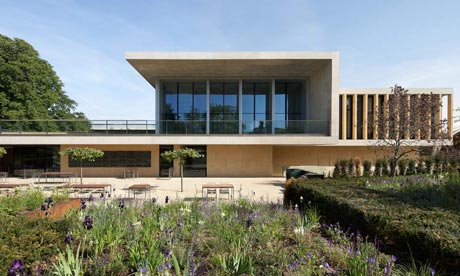IaI: The Institute of Art and Ideas » The Institute of Art and Ideas
Thursday, December 13, 2012
Tuesday, December 4, 2012
The Communist legacy in architecture
A nice article on some of the more interesting pieces of communist architecture in Eastern Europe.
This cladding on the Chemnitz Stadthalle looks quite reminiscent of the Selfridges in Birmingham, except that it was built in the early 1970s. OK, you don't know where Chemnitz is either: the former East Germany, now Saxony.
There's more about these Communist era structures in the piece at www.theawl.com/2012/12/the-sublime-sci-fi-buildings-that-communism-built. Also lots more photographs and drawings in a follow-up piece at The Verge.
This cladding on the Chemnitz Stadthalle looks quite reminiscent of the Selfridges in Birmingham, except that it was built in the early 1970s. OK, you don't know where Chemnitz is either: the former East Germany, now Saxony.
There's more about these Communist era structures in the piece at www.theawl.com/2012/12/the-sublime-sci-fi-buildings-that-communism-built. Also lots more photographs and drawings in a follow-up piece at The Verge.
Wednesday, November 21, 2012
Catslide Roof
This is a term I'd never come across until a few days ago. What is a catslide roof? Well, it's a roof that covers the outshot by a continuous extension of the main roof, often ending up six feet or less from the ground. Why is it a catslide: supposedly because cats get out on the roof, and when it rains they slide down to the ground. Hmm...
Here's an illustration:
What's an outshot? It's a building extension that gets covered by a catslide roof. As opposed to a lean-to, which doesn't: it has it's own roof which abuts the end wall.
On the more general subject of roofs, there's a great listing of types, with illustrations at: http://www.geograph.org.uk/article/Roof-Types. And more illustrations of common UK building definitions too.
Here's an illustration:
(from www.localhistory.co.uk: a good resource for other building definitions)
On the more general subject of roofs, there's a great listing of types, with illustrations at: http://www.geograph.org.uk/article/Roof-Types. And more illustrations of common UK building definitions too.
Monday, November 19, 2012
Why do people feel more comfortable in one space than another?
The impact of neuroscience on architecture. Well it seems to be impacting on everything else, so why not?
This article Corridors of the Mind, reports on a conference in La Jolla, California, organised by the Academy of Neuroscience for Architecture.
This article Corridors of the Mind, reports on a conference in La Jolla, California, organised by the Academy of Neuroscience for Architecture.
Architects “understand about aesthetics; they know about psychology. The next depth to which they can go is understanding the brain and how it works and why do people feel more comfortable in one space than another?”
This is an admittedly abstract concept. To help explain, architects often tell this story: Early in his career, when he was still struggling to find a cure for polio, Jonas Salk retreated to Umbria, Italy, to the monastery at the Basilica of Assisi. The 13th-century Franciscan monastery rises out of the hillside in geometric white stone, with Romanesque arches framing its quiet courtyards. Salk would insist, for the rest of his life, that something about this place—the design and the environment in which he found himself—helped to clear his obstructed mind, inspiring the solution that led to his famous polio vaccine.
Tuesday, November 6, 2012
New talks: Cumbrian architecture
There are two talks being given locally in the next couple of weeks that might be of interest:
- Inside the Cumbrian Farmhouse, by Andy Lowe, who recently spoke at the U3A monthly meeting. The talk is under the auspices of the North Lonsdale Society, and is being held in the Blackburn meeting room of Ulverston Methodist Church on Neville Street, at 7.30 pm. on Tuesday, 13th November. Non-members can attend for £2 at the door.
- Revising the Cumbria Pevsner, by Gavin Weston, who wrote the new Industrial History introduction for the volume. The meeting is being held by the Cumbrian Industrial History Society, and apparently is an open meeting. At Greenodd Village Hall, Wednesday, 14 November: 7.30 pm.
Monday, October 29, 2012
Jonathan Meades on extraordinary buildings
 |
| (c) The Guardian |
The article doesn't have links to the photos for each choice, so here they are:
David Murray John Tower, Swindon
Cothay Manor, Somerset
Walhalla Temple, Bavaria
Stewart’s Melville College, Edinburgh
Marseille Cathedral
These and other architectural pieces are from ‘Museum Without Walls’, by Jonathan Meades, available from Amazon here.
Tuesday, October 23, 2012
Looking at Buildings
I've just added a link in Resources to the Looking at Buildings website which is based on the Pevsner Buildings of England series, now being splendidly updated by Yale University Press. Well worth a browse, with a Glossary, timeline and links to other major architectural sites. Some parts of the site are incomplete, with little sign of any updating going on, but what there is is useful.
The Stirling Prize, again
The Observer ran a piece by Rowan Moore, their Architecture editor, on the winner of the Stirling Prize, The Sainsbury Laboratory in Cambridge by Stanton Williams. Although I suggested that the short list was full of not very interesting buildings, Rowan Moore, through talking to Alan Stanton and Paul Williams, makes a case for a more condiered view. I particularly liked their comment about architecture and the senses:
Moore makes a good case for the winner, and I stand corrected.
(c) Brian Rosen "Touch and sense are fundamental. They are the ways in which architecture engages with people." Stanton and Williams's projects have got bigger since the 1980s, but they say they're still pursuing the same qualities. Their design of the Sainsbury Laboratory in Cambridge – which last week won this year's Stirling prize – is, among other things, about the effects of the stone, timber and concrete of which it is made, and the way in which it responds to the "path of the sun" and the "colour of the light".
Friday, October 12, 2012
Listed Buildings
While looking for a list of Listed Buildings in Cumbria (Ulverston Listed Buildings) in the panel on the right) I saw this list of some interesting building types, and couldn't resist repeating it:
I wonder how many of each of these there are in Cumbria?
There are about 360,000 listed buildings in England, and alongside 197 palaces, 425 castles, 14,393 churches and 3,369 country houses, there are many unusual listed buildings/structures throughout England, including:
(From the Visit Cumbria Listed Buildings website)
52 garden sheds
35 fishponds
1 racing pigeon loft
3,800 mile posts and stones
11 army camps
9 skating rinks
2,195 telephone boxes
489 pigsties
663 lavatories
192 post boxes
982 lamp posts
I wonder how many of each of these there are in Cumbria?
Stirling Architecture Prize
 The short-list for the RIBA Stirling Architecture prize for 2012 has just been published:
The short-list for the RIBA Stirling Architecture prize for 2012 has just been published:RIBA Stirling Architecture shortlist 2012
It's a rather boring selection. The long list contained more interesting buildings, in my view. The Guardian has a slide show of the long list:
Guardian Stirling prize long-list slideshow
Subscribe to:
Posts (Atom)



